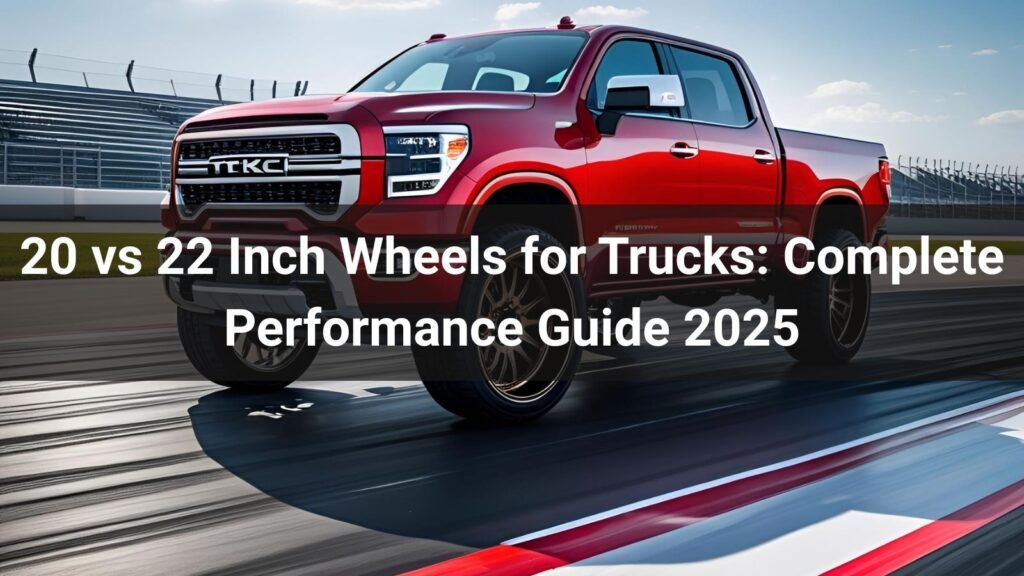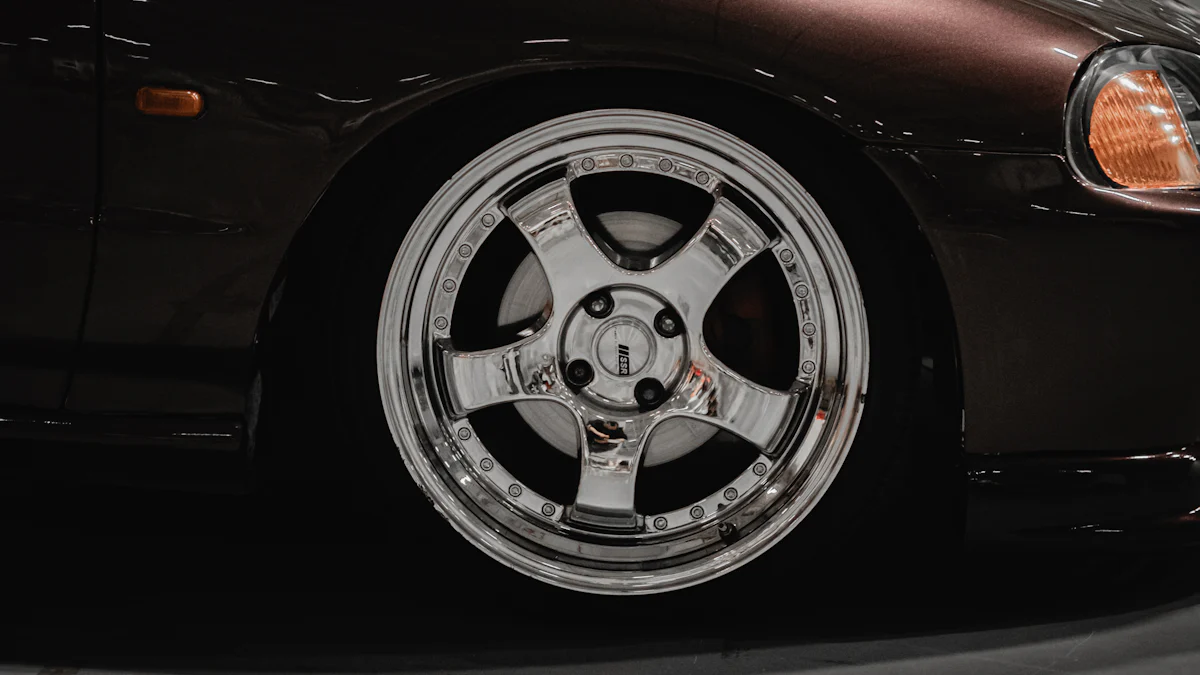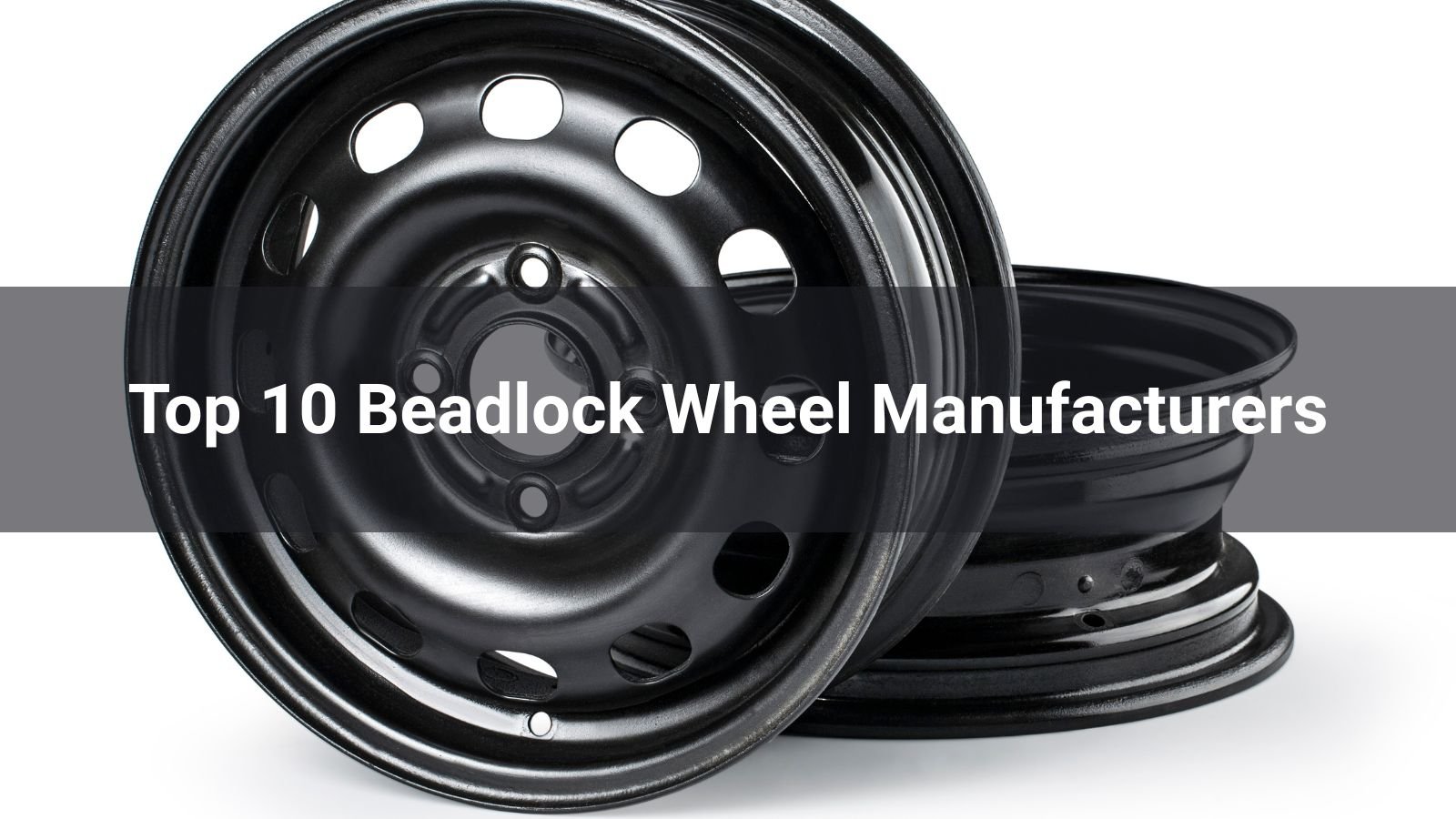
Choosing between 20-inch and 22-inch wheels for your truck significantly impacts performance, comfort, fuel economy, and overall driving experience. This comprehensive analysis examines the pros and cons of each size, helping truck owners make informed decisions based on their specific needs, driving conditions, and performance priorities. We’ll explore everything from ride quality and handling to cost considerations and tire availability.
📋 Table of Contents
Understanding Wheel Size Fundamentals and Their Impact on Truck Performance
The debate between 20-inch and 22-inch wheels for trucks involves more than just aesthetic preferences. Wheel diameter directly affects multiple aspects of vehicle performance, including ride quality, handling characteristics, fuel efficiency, and maintenance costs. Understanding these fundamental relationships is crucial for making an informed decision.
When you increase wheel diameter, several changes occur simultaneously:
- Tire sidewall height decreases: Larger wheels require lower-profile tires to maintain overall wheel-and-tire diameter
- Unsprung weight typically increases: Larger wheels are generally heavier, affecting suspension performance
- Contact patch characteristics change: Lower-profile tires can provide different road contact patterns
- Visual proportions shift: Larger wheels create a more aggressive, modern appearance
Key Performance Metrics Affected by Wheel Size:
| Performance Aspect | Impact of Larger Wheels | Significance Level |
|---|---|---|
| Ride Comfort | Generally Decreases | High |
| Handling Precision | Usually Improves | Moderate |
| Fuel Economy | May Decrease | Moderate |
| Tire Cost | Increases | High |
| Road Noise | Often Increases | Moderate |
20-Inch Wheels: The Balanced Performance Choice
Twenty-inch wheels have become increasingly popular on modern trucks, representing what many consider the sweet spot between performance, comfort, and practicality. This size offers significant advantages over smaller factory wheels while avoiding many of the compromises associated with ultra-large diameters.
Advantages of 20-Inch Wheels:
Superior Ride Quality: Compared to 22-inch wheels, 20-inch options allow for more tire sidewall, which acts as additional suspension. This extra cushioning translates to better absorption of road imperfections, potholes, and general surface irregularities that truck drivers encounter daily.
Better Tire Selection and Availability: The 20-inch market offers extensive tire options across all categories – from all-season and winter tires to high-performance and off-road variants. This variety ensures you can find tires optimized for your specific driving needs and budget requirements.
Cost Effectiveness: Twenty-inch tires are generally 15-25% less expensive than comparable 22-inch options. Over the life of a truck, this cost difference becomes significant, especially when considering that most truck owners replace tires every 40,000-60,000 miles.
Enhanced Durability: The additional sidewall height provides better protection against pothole damage and curb impacts. The increased air volume also helps dissipate heat more effectively, potentially extending tire life in demanding conditions.
Improved Fuel Economy: Twenty-inch wheels typically weigh less than 22-inch equivalents and allow for tires with better rolling resistance characteristics. Many truck owners report 1-2 MPG improvements when downsizing from larger wheels to 20-inch options.
Potential Drawbacks of 20-Inch Wheels:
Less Aggressive Appearance: While still providing a substantial upgrade over factory 17-18 inch wheels, 20-inch wheels may not deliver the dramatic visual impact that some truck enthusiasts desire.
Moderate Handling Improvements: While handling is improved compared to smaller wheels, the gains may be less pronounced than those achieved with 22-inch wheels, particularly in high-performance driving situations.
At Ningbo BRS Auto Parts Co., Ltd, we manufacture high-quality 20-inch steel wheels specifically designed for truck applications. Our precision engineering ensures optimal strength-to-weight ratios while maintaining the durability truck owners demand.
22-Inch Wheels: Maximum Visual Impact and Performance
Twenty-two-inch wheels represent the larger end of the practical spectrum for most truck applications. They offer distinct advantages in certain areas while requiring compromises in others. Understanding these trade-offs is essential for determining if 22-inch wheels align with your priorities.
Advantages of 22-Inch Wheels:
Dramatic Visual Impact: Twenty-two-inch wheels fundamentally transform a truck’s appearance, creating a more aggressive, modern, and premium aesthetic. The larger diameter fills wheel wells more completely, creating better visual proportions on today’s larger trucks.
Enhanced Handling Precision: The reduced sidewall height of tires mounted on 22-inch wheels provides less sidewall flex during cornering and maneuvering. This translates to more precise steering response and better overall handling characteristics, particularly beneficial for performance-oriented driving.
Improved Braking Performance: Larger wheels provide more space for bigger brake components. While most truck owners won’t upgrade brakes simultaneously, the additional clearance can improve cooling airflow around existing brake components.
Increased Ground Clearance: When maintaining overall wheel-and-tire diameter, 22-inch wheels can provide slightly more ground clearance than smaller alternatives, beneficial for light off-road use or navigating parking lot obstacles.
Significant Considerations with 22-Inch Wheels:
Compromised Ride Quality: The reduced tire sidewall height significantly impacts ride comfort. Road imperfections, expansion joints, and surface irregularities are transmitted more directly to passengers, creating a firmer, sometimes harsh ride quality.
Higher Costs: Beyond the initial wheel cost, 22-inch tires are substantially more expensive than 20-inch alternatives. Performance and premium tire options in 22-inch sizes can cost $300-500 per tire, compared to $200-350 for comparable 20-inch options.
Increased Damage Risk: Low-profile tires are more susceptible to pothole damage, sidewall tears, and rim damage from curb impacts. This vulnerability can lead to frequent tire replacements and potential wheel repairs.
Limited Tire Selection: While improving, the 22-inch tire market still offers fewer options, particularly in specialized categories like winter tires or heavy-duty commercial applications.
Direct Performance Comparison: 20-Inch vs 22-Inch Wheels
To help clarify the differences between these two popular sizes, here’s a comprehensive performance comparison based on real-world testing and user feedback:
| Performance Category | 20-Inch Wheels | 22-Inch Wheels | Winner |
|---|---|---|---|
| Ride Comfort | Excellent | Good | 20-Inch |
| Handling Precision | Very Good | Excellent | 22-Inch |
| Fuel Economy | Better | Good | 20-Inch |
| Visual Appeal | Very Good | Outstanding | 22-Inch |
| Tire Cost | $200-350/tire | $300-500/tire | 20-Inch |
| Durability | Excellent | Good | 20-Inch |
| Tire Selection | Extensive | Good | 20-Inch |
| Off-Road Capability | Very Good | Fair | 20-Inch |
Ride Quality and Comfort: The Critical Difference
Perhaps no factor differentiates 20-inch and 22-inch wheels more dramatically than their impact on ride quality. This difference stems primarily from tire sidewall height and its role in suspension performance.
How Tire Sidewall Affects Ride Quality:
Tire sidewalls function as an additional suspension component, cushioning impacts and absorbing road irregularities. When you move from a 20-inch to a 22-inch wheel while maintaining overall diameter, sidewall height typically decreases by approximately 20-25mm per side. This reduction significantly impacts the tire’s ability to absorb impacts.
Real-World Comfort Differences:
- Highway Cruising: On smooth highways, the difference is minimal, with both sizes providing acceptable comfort levels
- City Driving: Urban environments with expansion joints, manhole covers, and varied pavement quality highlight the comfort advantage of 20-inch wheels
- Rough Roads: On damaged or unpaved surfaces, 22-inch wheels can become uncomfortable, with impacts transmitted directly to passengers
- Parking Lots: Speed bumps and parking lot transitions are notably harsher with 22-inch wheels
Professional Driver Feedback:
Surveyed truck owners consistently report that ride quality is the most noticeable difference between wheel sizes. Those prioritizing comfort for daily driving typically prefer 20-inch wheels, while drivers focused on appearance and handling performance accept the comfort trade-offs of 22-inch wheels.
Our engineering team at BRS Auto Parts designs wheels with optimal weight distribution to minimize negative impacts on ride quality, regardless of diameter. Our 20-inch options provide the best balance of performance and comfort for most truck applications.
Comprehensive Cost Analysis: Initial Investment and Long-Term Ownership
The financial impact of choosing between 20-inch and 22-inch wheels extends far beyond the initial purchase price. Understanding total cost of ownership helps make a financially sound decision.
Initial Costs Breakdown:
| Cost Category | 20-Inch Setup | 22-Inch Setup | Difference |
|---|---|---|---|
| Wheels (set of 4) | $1,600-2,400 | $2,000-3,200 | +$400-800 |
| Tires (set of 4) | $800-1,400 | $1,200-2,000 | +$400-600 |
| Installation/Mounting | $200-300 | $200-300 | Similar |
| Total Initial Cost | $2,600-4,100 | $3,400-5,500 | +$800-1,400 |
Long-Term Ownership Costs:
Tire Replacement Frequency: Twenty-inch tires typically last 40,000-60,000 miles under normal driving conditions. Twenty-two-inch tires may experience 10-20% shorter life due to reduced sidewall protection and higher performance compounds often used in low-profile applications.
Repair and Damage Costs: Low-profile tires on 22-inch wheels are significantly more susceptible to damage from potholes, debris, and curb contact. Industry data suggests 22-inch setups experience 30-40% higher damage-related replacement rates.
Fuel Economy Impact: Twenty-inch wheels typically provide 1-2 MPG better fuel economy due to lighter weight and lower rolling resistance tires. Over 15,000 miles annually, this can represent $200-400 in fuel savings.
5-Year Total Cost of Ownership Example:
For a truck driven 15,000 miles annually:
- 20-inch wheels: $2,800 initial + $1,600 tire replacements + $0 damage = $4,400 total
- 22-inch wheels: $4,000 initial + $2,400 tire replacements + $800 damage = $7,200 total
- Cost difference: $2,800 over 5 years ($560 annually)
Practical Applications: Choosing Based on Your Truck’s Purpose
The optimal wheel size depends heavily on how you use your truck. Different applications favor different wheel sizes based on performance priorities and practical considerations.
Daily Driving and Commuting:
Recommendation: 20-inch wheels
For trucks used primarily for daily transportation, 20-inch wheels offer the best balance of comfort, cost-effectiveness, and performance. The superior ride quality reduces driver fatigue during long commutes, while lower operating costs help manage the total cost of vehicle ownership. The extensive tire selection ensures you can find options optimized for your local climate and driving conditions.
Towing and Heavy Hauling:
Recommendation: 20-inch wheels
Towing applications benefit from the durability advantages of 20-inch wheels. The additional tire sidewall provides better protection against the increased stresses of trailer loads. Heat dissipation is also superior with larger air volumes in 20-inch tires, crucial for maintaining tire integrity during extended towing operations. Our steel trailer wheels are specifically engineered for demanding towing applications.
Off-Road and Adventure Use:
Recommendation: 20-inch wheels
Off-road driving strongly favors 20-inch wheels due to tire availability and durability. The all-terrain and mud-terrain tire selection is far superior in 20-inch sizes. Additionally, the increased sidewall height provides better protection against punctures and allows for lower air pressures when traversing soft surfaces like sand or mud.
Show Trucks and Custom Builds:
Recommendation: 22-inch wheels
When appearance is the primary concern, 22-inch wheels deliver unmatched visual impact. Show trucks and custom builds benefit from the dramatic transformation these wheels provide. However, owners should be prepared for the comfort and cost compromises that accompany this choice.
Performance-Oriented Driving:
Recommendation: 22-inch wheels
Trucks used for performance driving, autocross, or track events benefit from the improved handling precision of 22-inch wheels. The reduced sidewall flex provides better steering response and cornering performance, though this comes at the cost of ride comfort in daily driving situations.
Expert Recommendations and Final Decision Framework
Based on extensive industry experience and customer feedback analysis, here are our professional recommendations for choosing between 20-inch and 22-inch truck wheels:
Choose 20-Inch Wheels If:
- Daily comfort and ride quality are priorities
- You frequently drive on rough or damaged roads
- Cost management is important (both initial and long-term)
- You need maximum tire selection flexibility
- Your truck is used for towing or hauling
- Off-road capability is desired
- You prefer better fuel economy
Choose 22-Inch Wheels If:
- Appearance and visual impact are primary concerns
- You primarily drive on smooth, well-maintained roads
- Handling precision is more important than comfort
- Budget allows for higher initial and operating costs
- Your truck is primarily for show or weekend use
- You accept the comfort trade-offs for style benefits
Professional Installation and Quality Considerations:
Regardless of size choice, professional installation is crucial for safety and performance. Key factors include:
- Proper torque specifications: Ensure wheels are mounted to manufacturer specifications
- Balancing accuracy: Larger wheels require precise balancing for smooth operation
- TPMS compatibility: Verify tire pressure monitoring system compatibility
- Load rating verification: Confirm wheels and tires meet your truck’s load requirements
Why Choose BRS for Your Truck Wheel Needs:
At Ningbo BRS Auto Parts Co., Ltd, we bring over 20 years of specialized experience in truck wheel manufacturing. Our comprehensive approach ensures you receive the optimal solution for your specific needs:
- Engineering Expertise: Over 10 professional technicians specializing in 2D, 3D, and CAE analysis for optimal wheel design
- Quality Manufacturing: Precision shot blasting process ensures superior surface preparation and coating adhesion
- Extensive Range: Steel rims from 16″ to 24″ with custom sizing options available
- Proven Durability: High-quality raw steel transformed through precision cutting technology for maximum durability
- Professional Support: Comprehensive consultation to help select optimal wheel specifications
- Reliable Delivery: Consistent 2-month production schedule with regular progress updates
Contact Our Wheel Specialists:
Address: 1st, Rili Middle Road, Yinzhou District, Ningbo, China
Phone: 0086 19810666863
Email: carrie@brsautoparts.com
WhatsApp: 0086 19810666863
Website: https://brsrim.com/
Working Hours: 8:00 – 21:00 Monday to Friday (24-hour response on holidays)
Conclusion:
The choice between 20-inch and 22-inch truck wheels ultimately depends on your priorities, driving conditions, and budget considerations. Twenty-inch wheels offer superior ride comfort, better cost-effectiveness, and greater practicality for most truck applications. They’re ideal for daily drivers, towing operations, and users who prioritize comfort and value.
Twenty-two-inch wheels excel in visual impact and handling precision but require compromises in comfort and cost. They’re best suited for show applications, performance-oriented driving, or users who prioritize appearance over other considerations.
For most truck owners, 20-inch wheels represent the optimal balance of performance, comfort, and value. However, the final decision should align with your specific needs and priorities. Our technical team at BRS is available to provide personalized recommendations based on your truck specifications and intended use.
Contact us today to discuss your wheel requirements and discover how our precision-engineered solutions can enhance your truck’s performance and appearance while delivering exceptional value and durability.






